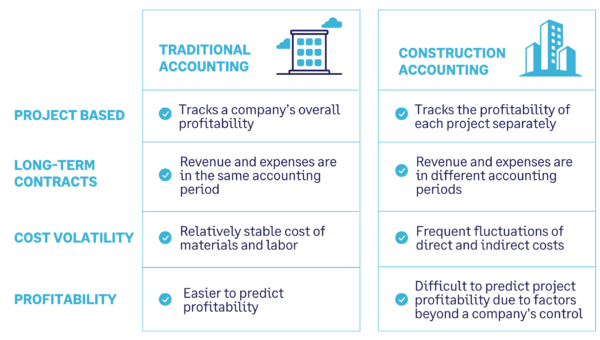Construction Accounting vs Regular Accounting

Accounting forms the backbone of any business, providing insights into financial health and guiding strategic decisions. However, for companies in the construction industry, accounting practices are shaped by the industry’s distinctive nature. Traditional accounting applications simply were not designed to support the unique requirements of construction companies. What are the differences in construction accounting vs regular accounting? And what is the best construction accounting software tool for the job?
The Project-Centric Puzzle
Unlike traditional accounting, which focuses on the overall financial status of a company, construction accounting is inherently project-centric. Each project is treated as a separate profit center, with its revenues and expenses meticulously tracked. Typical accounting applications are not designed to support project-based accounting. As a result, construction businesses often use disparate applications to manage their projects and their accounting — making it difficult to get a complete view of the business.

Sage Intacct Construction specializes in project-centric accounting, offering real-time insights into each project’s financial health, ensuring every venture adds value to the overall business. By incorporating world-class financials with proven construction capabilities, your business benefits from a single source of the truth.
The Revenue Recognition Challenge
Construction projects typically span months or even years, complicating revenue recognition in construction accounting. Your construction company may use the percentage-of-completion method, where revenue, expenses, and profits are recognized progressively. This is another area where typical accounting applications falter.
Sage construction software supports various contract revenue recognition methods, including the percentage-of-completion approach. This flexibility aids in compliant and accurate financial reporting. The construction accounting software also ensures adherence to evolving accounting standards and regulatory requirements, a vital aspect for construction businesses.
Costing In Construction
Job costing in construction accounting is a complex exercise involving tracking direct costs and allocating indirect job costs to specific projects. Accurately tracking project costs is crucial but challenging to accomplish in typical accounting applications.
Sage Intacct Construction’s sophisticated job costing capabilities allow you to accurately track direct and indirect costs associated with each and every construction project. It simplifies the allocation of expenses and revenues, making it easier to assess the financial health of each project. In addition, Sage Intacct Construction’s advanced reporting tools provide critical financial data in an understandable format, facilitating informed decision-making.
Dealing with Volatility
The construction industry is subject to frequent fluctuations in material costs and unexpected project changes. Change orders are common and necessitate agile accounting practices to track job costs and capture their financial implications accurately.
Sage Intacct Construction Accounting delivers real-time financial visibility. Its dashboard and analytics tools provide your teams with up-to-the-minute financial data, enabling quick responses to market fluctuations and project changes. Additionally, its integration capabilities with construction industry-specific tools like Corecon (recently acquired by Sage and renamed Sage Construction Management), Procore, Sage Intacct Real Estate (property management), Sage Intacct Construction Payroll, Autodesk Navisworks, and more.
Compliance and Bonding
Construction companies often face stringent regulatory requirements) and typically need to secure bonds, necessitating maintaining strong accounting principles including financial positions and detailed, transparent accounting records.
By maintaining comprehensive and transparent accounting records, Sage Intacct Construction Accounting helps your construction business strengthen — and demonstrate — its financial standing. This is crucial for securing bonds and for demonstrating financial reliability to stakeholders.
Multi-Entity Accounting
Managing the books for a single-location or single-entity construction company is challenging enough but grows more difficult if your organization operates across different projects, locations, or entities. Managing financials in construction accounting requires a more sophisticated system to handle multiple entities than many accounting applications provide.
Sage Intacct Construction Accounting handles multiple entities in the most efficient way possible. Many Sage Intacct clients we work with effectively manage dozens of individual entities, producing consolidated financial statements for any or all of them in seconds.
Sage Intacct Construction – Built for Builders
Amid the challenging landscape of construction accounting, Sage Intacct Construction empowers businesses to navigate their financial journey with confidence. By addressing the specific pain points of construction accounting at the forefront of transforming these challenges into opportunities for growth, efficiency, and profitability.
MicroAccounting helps construction companies navigate their financial landscape with confidence, ensuring efficiency, compliance, and profitability in their ventures. We’re ready to help you, too. Contact us to get started.




